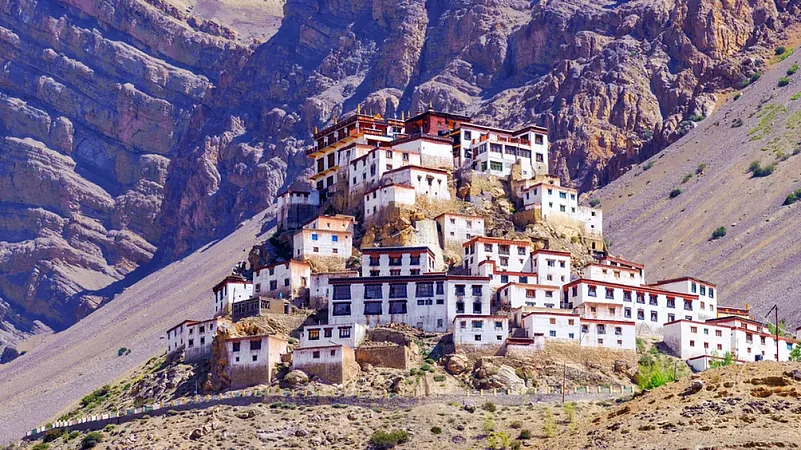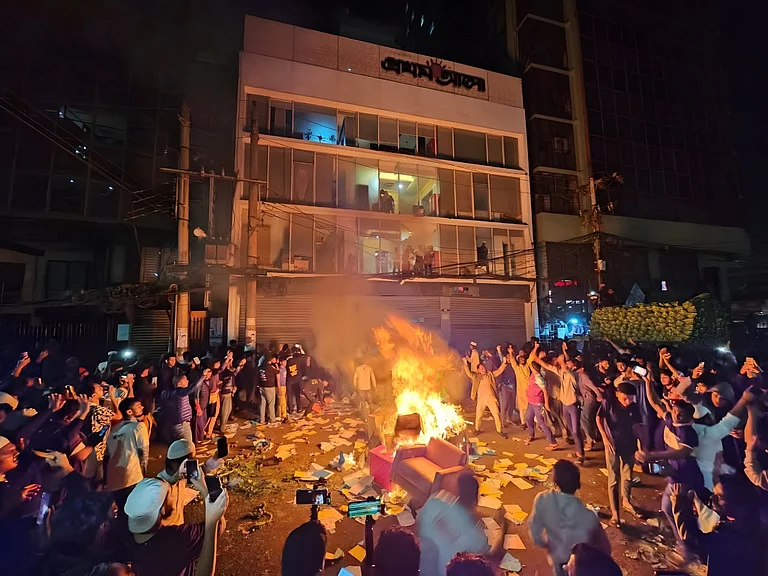Before tourism expanded in Himachal, I used to hear my relatives talk about the advantages of living in a cement house (like me in Delhi). They would say that their traditional wooden houses were harder to maintain. A few years later, while interning with the incredible India Lost and Found project and locating heritage monuments/houses in Garzha (Lahaul valley), I was shaken a bit when I found that the traditional Khar of our village had been rebuilt into a modern house - probably due to the same reasons that my relatives had mentioned a few years ago.
In the past few years, tourism has expanded everywhere, with people keen on exploring the unknown, and indigenous populations in remote areas transforming their places into homestays or building guesthouses to earn some extra income. What the people are late to realise is that these constructions and reconstructions have led not just to environmental degradation, but also to the loss of traditional houses and styles of living.
This is where an organisation like Indi Architecture steps in. It is a social enterprise located in Spiti, Himachal Pradesh which strives to protect, conserve and teach the methods of vernacular architecture - a path to sustainable living.
I spoke to the founder of Indi Architecture, Kimberley Moyle, on her journey, inspiration and mission. Moyle is a nomadic traveller and cyclist from Australia, who found her passion for sustainable living through her travels across Asia. Travelling in different terrains and regions of Asia exposed her to rich cultural traditions including vernacular architecture.
Here are extracts from the interview.
Preserving Knowledge Through Travel
As a world traveller with a passion for culture and experiencing different ways of living and being in the world, Moyle says her preference has always been to visit less industrialised countries with strong living cultures and connections with their heritage. "However, in all the countries I visited, I saw the same pattern repeated," she says. "Traditional vernacular homes being torn down and replaced with homogenous concrete boxes. Along with the loss of these beautiful, climatically appropriate buildings made from locally available resources, there was an even greater silent loss taking place. That is, intergenerational knowledge of how to build these unique structures, knowledge that has been experimented with and honed over hundreds of years, knowledge that is a reflection of human creativity and ingenuity, knowledge that allowed people to live in the heat of the Rajasthani deserts, the humidity of the Keralan backwaters and the freezing temperatures of the Himalayas, all without the need for electric powered heating or cooling. Whereas in the homes they have been replaced with it is unimaginable that one could survive a summer without an AC. Seeing all of this taking place alongside debates about climate change and the need for sustainable living, seemed paradoxical. Why were we not learning from these traditional artisans? They were already experts in sustainable house design. We don't need to reinvent the wheel. We need to honour the traditional knowledge these artisans carry with them."
Moyles says she has seen a growing number of people becoming interested in natural building with a desire to build their own homes from natural materials with their own hands. However, no one was offering opportunities to learn directly from master artisans. "I saw a niche where I could focus my passion. The idea for Indi Architecture was born."
Indi Architecture in its current incarnation is just two years old. Moyle had been searching for a space where she could use her unique skills to create positive social change. The lockdown during COVID gave her some extra time and space to think creatively.
Moyle says that they have seen that wherever one still finds traditional architecture dominant, you will also find traditional culture thriving. That's because, as she explains, "architecture is such an obvious expression of culture and travelling to regions where vernacular architecture is alive and well is inspiring."

The Tours And Workshops
For now, Indi Architecture is working in Himachal Pradesh, Rajasthan, Andhra Pradesh, and Gujarat. However, they also have plans for Madhya Pradesh, Odisha. and Chattisgarh. You can choose from the two different models they have for tours. The first is that of workshops, wherein they seek out artisans, learn from them their unique vernacular tradition, and then collaborate with them to devise a workshop showcasing them and their skills. During these workshops, Indi Architecture will expose you to the traditional wisdom held by artisans supported by the scientific understanding of their techniques. "We also try to find interesting locations to host the workshops, such as Nandpur Fort in Himachal Pradesh - a 200-year-old haveli overlooking the Pong Dam but nestled in a quaint village," sys Moyle. "Or Hodka village in Kutch where we stay with Bharmabehns extended family while she teaches us Lippan Kaam and Chitra Kaam - sculptural mud relief work. Our guests become immersed in the experience of life in these regions."
The second style of tour is the Culture and Architecture tours. In these, they specifically focus on regions with strong architectural traditions that are still alive - like Spiti Valley and Kinnaur in Himachal Pradesh.
If you go on one of the tours, you will be able to better appreciate the design and functionality that goes into India's vernacular architecture - something clearly visible in the gallery on their website comprising entrances and doorways. The doors for Moyle are just one example of how something completely utilitarian can make a beautiful artistic statement. "I see it in so many aspects of vernacular architecture. Niches in walls, fencing a boundary, handmade household items such as the floor mats of Chattisgarh woven from grasses or the woolen carpets of Spiti spun from the wool of their own animals. In vernacular traditions, everyday items are pieces of art."
On these tours, Indi Architecture takes guests off the beaten path to meet interesting locals, explore hidden villages, experience diverse ways of living, meet inspiring people and enjoy home-cooked local cuisine. "Our workshops and tours enable people to travel and learn something new. That could be learning about Rajasthani plasters or Mohrakashi lime frescoes, or it could be learning about the culture of the Spiti Valley. However, alongside all of this, an experiential traveller is also learning about themselves. When we learn something about a new culture, we are encouraged to reflect on our own world views; what we take for granted or see as normal is quickly revealed as inherently culturally determined. Seeing the world through the lens of another culture is fascinating. As an Australian living and working in India, I am constantly inspired by diverse cultures so very different from my own."
The sorts of people drawn to the workshops are architects, interior designers, artists, natural builders, people looking to live more sustainably and people with a unique interest in traditional architecture. Their tours attract people with an interest in culture and slow travel, wanting to get to know a region on a deeper level.
Apart from signing up for workshops and tours, you can also volunteer or intern with them, depending on the projects ongoing. They welcome passionate people with unique skills to share along with a desire to learn and give something back.
Moyle says that one of the biggest impacts of their workshops has been the public exposure that the artisans receive - they publicise them and their tradition, making them accessible to people looking for such artisans and demand for their work increases. When their communities see their traditions being valued by people willing to travel from far and wide to learn, they too once again begin to value those traditions that had been slowly losing favour.
Indi Architecture has conducted workshops on Rajasthani Lime Plasters and Flooring, Kutchi Sculptural mud work reliefs and wood carving, and their first Mohrakashi Lime Fresco workshop which will conclude on May 25. "Our workshops are a collaborative effort between myself and the artisans. The artisans teach their traditions from their practical experiential perspective and I support that by teaching the science behind the techniques. Doing so, I believe, highlights the ancient wisdom behind these methods."
So how does she choose the artisans for these workshops? "I travel across India searching for artisans. I first learn their tradition from them and then go on to collaborate with them to host workshops. I am always on the lookout for more artisans to work with. Sometimes people will give me recommendations; others I just visit a region and start searching."

The Location In Spiti
Indi Architecture is based out of Spiti Valley, a remote location that was only opened up to outsiders in the early 1990s. Until just a couple of years ago the region really only attracted the most adventurous of travellers as the journey was long and the comforts available limited. In the last couple of years, however, tourism has exploded in the valley. "Now we are seeing a tide of tourists wanting only to visit the 'world's highest' anything in order to update their Instagram. The local culture is not even a consideration. We actually also run a hotel in Kaza - Hotel Deyzor. If people are not on a tour with us, but just staying with us in Kaza, we also try to encourage our guests to spend time in the villages, stay with locals, have lunch with our friends, and visit unexplored locations. They may not come for the culture, but leave with their fondest memories because of it."
Indi Architecture is also into the traditional home restoration process. "This is an aspect of our venture that we are currently working on. We have our eye on a couple of heritage homes in Spiti Valley. We are still in negotiations with the owners before we begin restoration. The plan is though, that we will engage local master artisans to perform the restoration. During which we will invite some interns to join us as well as host workshops throughout various phases."
Vernacular Architecture and Sustainabiliy
Moyle says vernacular architecture is a part of the preservation of cultures, as it is a significant aspect of local culture. As a traveller, it is one of the most obvious expressions of culture. "When you travel in Spiti Valley and see the flat mud roofs and rammed earth walls of the Tibetan-style homes, you know they don't experience much rainfall. You can also see in that treeless landscape why they learned to use timber so frugally. When you visit Chanderi in Madhya Pradesh and see the stone houses without the timber bracing of the Kath Kuni of Himcahal, you know that earthquakes have not been a problem for them in the plains like they have in the Himalayas, where they developed a brilliant system of earthquake resilient design.
In our current era of climate crisis, localised knowledge of sustainable construction methods, suited to local climatic contexts is extremely valuable, Moyle points out. The knowledge that these artisans carry with them is not only their own, but that of generations. "The designs and use of materials have been adapted and perfected over time through careful experimentation, learning from failures and successes and adapting. One really important aspect of our work is to give respect to the artisans who carry with them such specialised knowledge and skills gained through a traditional master and disciple tradition. Unfortunately, in India there is a very strong system of highly valuing those with bookish knowledge attained through years of study in formal institutions and a distinct lack of respect for the artisans who have learned their unique crafts, practically, honing their skills over a lifetime."
We have all at one time or another marveled at some ancient form of engineering, like the Pyramids of Egypt or Mexico, or the fine stone work of ancient temples. How were they constructed? "It seems incredible that our modern minds are unable to decipher the engineering that made it possible. That is why when we have a living tradition, we should safeguard that knowledge by keeping it alive. It should be considered collective human heritage. More precious than anyone building, it is the knowledge that went into creating it."
Moreover, she says, vernacular traditions always rely on locally available resources. In Spiti Valley those materials are available within a few kilometers of each village itself. For instance, at Pong Dam, they find the surki - brick powder - for our workshops within a ten minute drive. "However the lime is sourced from about four hours away. The environmental cost of transporting lime, however, can be offset by the long life and reduced maintenance costs."
The message that Indi Architecture wants to give future generations is that vernacular architecture is not static. "It is not something frozen in time. It has reached where it is today through generations of experimentation and adaptation. There are certainly aspects of traditional homes that may need adaptation to suit modern lifestyles; however, the technical knowledge underpinning these traditions is phenomenal and worthy of conservation and replication. Let's not throw the baby out with the bathwater. If there are some changes that need to be made, let's innovate rather than abandon them for inferior yet better marketed industrial materials."
The Workshops And Tours Coming Up In 2022
Their Mohrakashi Lime Fresco Workshop is happening right now at Nandpur Fort. An artisan has come from Punjab to teach the ancient art of lime fresco from the Mohrakashi tradition which is indigenous to Punjab. In September, they have a Secret Spiti Sojourn tour which Moyle will be leading, sharing with guests some hidden highlights of the Spiti Valley, both architectural, cultural and natural. "This tour is something we are really excited about as it is a deep dive into the culture of Spiti visiting many places that very few other travelers get to see. We are in the midst of planning a workshop in Spiti for October. We are hoping to build a single room cottage from foundation to roof, using the local rammed earth technique with a flat mud roof and passive solar design. We may also do an earthen flooring and plasters workshop as well."
In early November, they are back in Kutch for our Lippan and Chitra Kaam (sculptural mud relief) workshop. In late November, they have plans to host an extended Rajasthani Lime Plasters, Flooring and Water Tank Workshop in Sardarshahr Rajasthan, the hometown of the lime artisans.


























